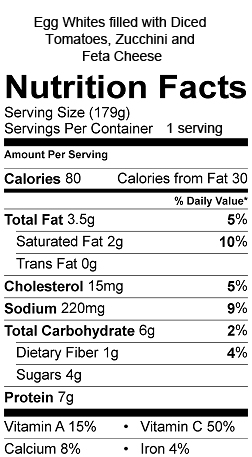Recipes
The following recipes are modified for low cholesterol and variety.
Egg Whites with Tomatoes,
Parsley and Bulgur
Parsley and Bulgur
Serves 2
Ingredients
2 Eggs, hard-boiled, yolks removed
4 Tablespoons Diced Tomatoes, Parsley, and Bulgur, prepared
Directions
4 Tablespoons Diced Tomatoes, Parsley, and Bulgur, prepared
Directions
Fill egg whites with diced tomatoes, parsley, and bulgur. Serve
Nutrition Information
Egg Whites filled with Diced Tomatoes,
Zucchini and Feta Cheese
Zucchini and Feta Cheese
Ingredients
1 Egg White, cut in half
1/2 cup Diced Tomatoes
1/3 cup Diced Zucchini
1/3 ounce Feta Cheese
Directions
Fill egg whites with ingredients. Serve
Resources and References
1. Wikipedia: Deviled Egg This article is licensed under the GNU Free Documentation License
2. Consumer Reports, Deviled Eggs are a Healthier Snack
Ensure accurate nutritional analysis for your recipes utilizing an extensive research database and over 35 years of experience. A valuable service for Media, Cookbook Publishers, Writers, Chefs, Recipe Websites, and the Recipe Blogger. Your readers will benefit from the Nutrition information and a Registered Dietitian. Contact: Sandra Frank, Ed.D, RDN, FAND at recipenews@gmail.com or call 954-294-6300






